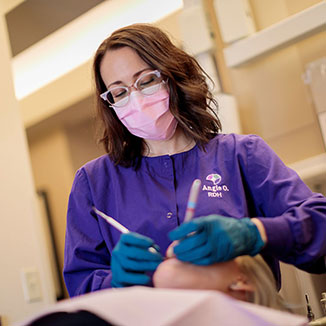Preventive dental care is essential throughout your life, no matter what your age is. By practicing good oral hygiene at home and scheduling regular checkups with our office, you can keep your smile bright and healthy for many years to come.
Here are a few simple ways you can prevent the build-up of plaque and cavities:
- Brush your teeth at least twice a day with a soft-bristled toothbrush. Use fluoride toothpaste to remove food particles and plaque from the tooth surfaces. Also be sure to brush the top surface of your tongue; this will remove any extra plaque-causing food particles, and help keep your breath fresh!
- Clean between your teeth by flossing at least once a day. You can also use a mouthwash to help kill bacteria and freshen your breath. Decay-causing bacteria can linger between teeth where toothbrush bristles can’t reach. Floss and mouthwash will help remove plaque and food particles from between the teeth and under the gum line.
- Eat a balanced diet, and try to avoid extra-sugary treats. Nutritious foods such as raw vegetables, plain yogurt, cheese, or fruit can help keep your smile healthy.
- Remember to schedule regular checkups with our office every six months for a professional teeth cleaning.
- Ask us about dental sealants, protective plastic coatings that can be applied to the chewing surfaces of the back teeth where decay often starts.
- If you play sports, be sure to ask Dr. McDonald or Dr. Gruchalla about special mouthguards designed to protect your smile.
If it’s been six months since your last dental checkup, then it’s time to contact our practice and schedule your next appointment!
- Brushing instructions
-
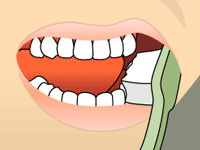
Brushing: Step 1
Place your toothbrush at a 45-degree angle to your gum.

Brushing: Step 2
Brush gently in a circular motion.
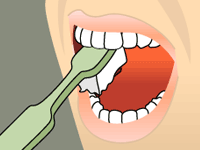
Brushing: Step 3
Brush the outer, inner, and chewing surfaces of each tooth.
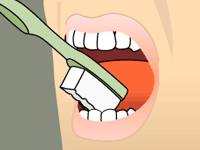
Brushing: Step 4
Use the tip of your brush for the inner surface of your front teeth.
- Flossing instructions
-
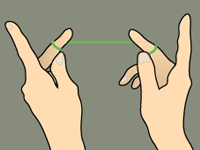
Flossing: Step 1
Wind about 18 inches of floss around your fingers as shown. Most of it should be wrapped around one finger, and the other finger takes it up as the floss is used.
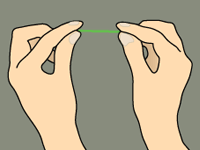
Flossing: Step 2
Use your thumbs and forefingers to guide about one inch of floss between your teeth.
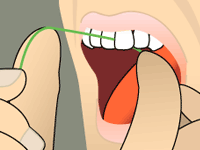
Flossing: Step 3
Holding the floss tightly, gently saw it between your teeth. Then curve the floss into a C-shape against one tooth and gently slide it beneath your gums.

Flossing: Step 4
Slide the floss up and down, and repeat for each tooth.
Oral Cancer Screening
Our office is not only dedicated to your smile, we’re also dedicated to your overall wellness. We take a holistic approach to your dental care, which includes an oral cancer screening as a part of your regular exam. Like other kinds of cancer, oral cancer can be life-threatening if not diagnosed and treated early.
We have the skills and tools to identify early signs and symptoms of oral cancer and pre-cancerous conditions. Though these symptoms may be caused by other, less serious problems, it is vital to visit our office to rule out the possibility of oral cancer. The most common symptoms of oral cancer include:
- Red or white spots or sores anywhere in the oral cavity
- A sore that bleeds easily or does not heal
- A lump, thickening, or rough spot
- Pain, tenderness, or numbness anywhere in the mouth or on the lips
- Difficulty chewing, swallowing, speaking, or moving the jaw or tongue
Our team is trained in a simple, quick screening that involves an examination of your oral cavity as a whole, and not just your teeth, to detect cancerous and precancerous conditions. Besides a visual examination of your mouth, we will also feel the tissue of your mouth and throat to detect any abnormalities.
If we find an area of concern, we may perform a simple test that collects cells from a suspicious lesion in the mouth to be sent to a laboratory for analysis. If this test comes back atypical or positive, we may recommend a biopsy.
Aside from receiving an oral cancer screening during your checkup at our office, there are many things you can do to help prevent oral cancer.
- The best way is to avoid all tobacco products and only drink alcohol in moderation.
- Maintain a healthy, balanced diet.
- Limit your exposure to the sun and always wear UV-A/B-blocking, sun-protective lotions on your skin as well as your lips.
- During your next dental appointment, ask us to perform an oral exam. Early detection of oral cancer can improve the chance of successful treatment.
Snoring Prevention
While snoring is a common problem for many people, it can also be a sign of other major health complications. It is estimated that more than 80 million people in North America snore while sleeping, which not only affects the quality of sleep of the person snoring, but also the quality of sleep of their loved ones and other family members. Luckily, there is a way to treat chronic snoring.
What causes snoring?
Snoring can be the result of several factors. Typically, it is caused by the relaxing of the muscles and soft tissues in the throat and mouth, which makes the air passage smaller. The decrease in space through the airway makes it harder for each breath to get through.
When it does get through, it moves over the soft tissues in the mouth and throat, and causes a vibration that results in the snoring sound. Other causes of snoring may include:
- Excess body weight
- Alcohol consumption
- Certain sleep aides or sedatives
- Obstructive Sleep Apnea (OSA)
What is a Mandibular Advancement Device?
If you snore at night, then a mandibular advancement device (MAD) may represent a solution and a better night’s sleep! The MAD is a specially designed dental device that gently helps keep the lower jaw, or mandible, in a forward position, and increases the space between the airway passage to help you breathe better so you can get a full, quiet night’s rest.
Some devices also stop the tongue from falling back over your windpipe. We will fit these special appliances to meet your individual condition.
Is a MAD comfortable?
The answer is simple: YES! A mandibular advancement device is made to be comfortable, so you can sleep without even noticing you’re wearing it. It does not prevent you from breathing with your mouth open and will even eliminate snoring for patients with sinus congestion or allergies.
You may experience some slight stiffness of the jaw for the first few mornings after wearing the device, but this feeling is only temporary and will go away after you wake up and remove it.
To learn more about a mandibular advancement device, contact our practice and schedule an appointment and consultation.
